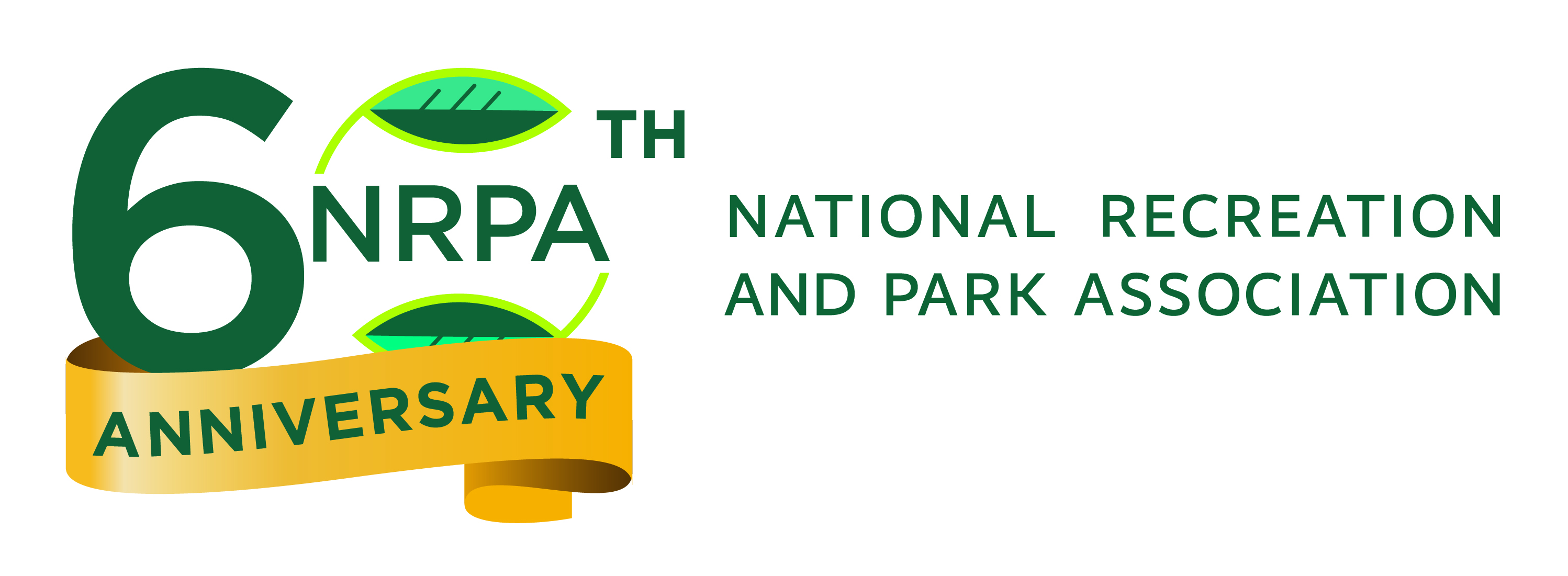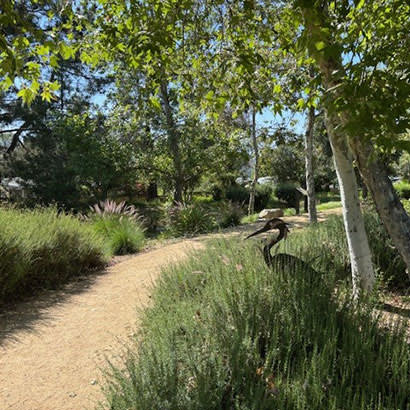
Pictured: Encanto Park in the City of Duarte, California, near the foothills of the San Gabriel Mountains. Photo courtesy Clement Lau.
Nearly every day, I go for a walk — sometimes in my neighborhood, sometimes in a local park, and sometimes just to clear my head between meetings. These walks have become a grounding part of my life. They help me stay physically active, reduce stress and reconnect with my surroundings. Whether it is a brisk morning loop or a slow evening stroll with family, I have come to cherish the time and space that walking provides. Often, it is during these moments of quiet movement that my best ideas surface.
This personal appreciation is part of why I care deeply about walking paths in parks. In my years of planning and engaging with communities on park and recreation issues, walking paths consistently emerge as one of the most requested and appreciated amenities. And it is easy to see why — they are simple, low-cost features that deliver enormous benefits, from health and well-being to social connection and environmental awareness.
Why Walking Matters
Walking is one of the most accessible and beneficial forms of physical activity. It does not require a gym membership or expensive equipment — just a safe and inviting place to move. Research shows that walking regularly helps reduce the risk of heart disease, stroke, diabetes and obesity, while also improving mood, sleep and cognitive function.
Many people are familiar with the idea of walking 10,000 steps per day. While that number can be a useful benchmark, recent studies suggest that even fewer steps — closer to 7,000 or 8,000 per day — can yield significant health benefits, especially for older adults. And for those just starting out, short and consistent walks can still make a big difference. In other words, every step counts.
Parks that feature walking paths make it easier for people to incorporate walking into their daily lives, whether they are taking a quick stroll on their lunch break or going for a longer walk with family or friends. These paths also support social interaction and mental well-being, offering moments of connection and calm that are increasingly valuable in our busy, high-stress lives.
Walking Paths in Action
To illustrate how walking paths contribute to community health, accessibility and quality of life, I would like to highlight four parks in Los Angeles County.
Earvin “Magic” Johnson Recreation Area
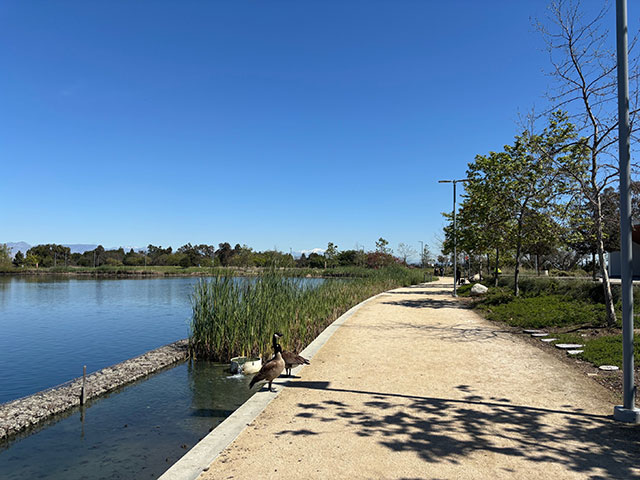
Pictured: A path along the water at Earvin “Magic” Johnson Recreation Area. Photo courtesy Clement Lau.
Located in the community of Willowbrook in South Los Angeles, the 120-acre Earvin “Magic” Johnson Recreation Area is a powerful example of park transformation and environmental justice. Built on a remediated former oil tank farm, the park serves as a vibrant green space with lakes, picnic areas, playgrounds, and — centrally — walking paths that connect it all.
The park’s walking paths loop around the park’s scenic features, offering splendid views of the water, native landscaping and gathering areas. The paths are wide, accessible and well-marked, welcoming walkers, joggers, families with strollers and users of all mobility levels. These walking paths are used by individuals and groups alike, including walking clubs and wellness programs organized by local organizations.
In addition to its walking paths, the park includes a dedicated fitness loop with outdoor exercise equipment, supporting a more holistic approach to physical activity. This thoughtful integration makes the park a true hub for community wellness — especially in a neighborhood that has long faced environmental and health challenges. The walking paths at Earvin “Magic” Johnson Recreation Area are more than just recreational — they are restorative. They reflect a commitment to reinvest in underresourced communities and provide clean, safe and beautiful spaces for all to enjoy.
Almansor Park
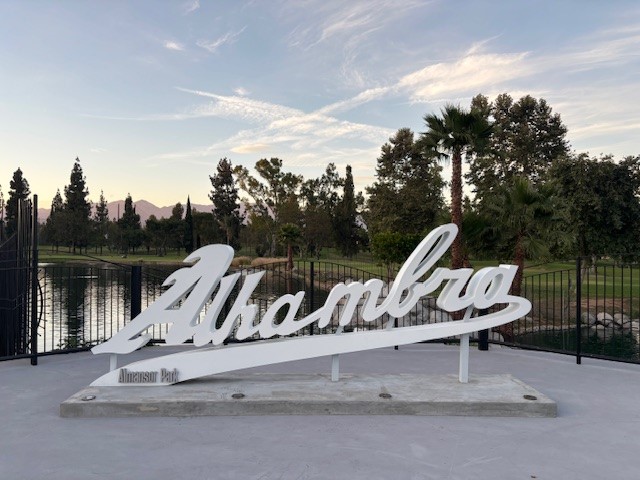
Pictured: Almansor Park. Photo courtesy of Clement Lau.
Almansor Park in the City of Alhambra is a popular destination in the San Gabriel Valley, known for its well-used walking path that encircles athletic fields, basketball courts, playgrounds and open lawns. The path is long enough to provide a meaningful walking workout and loops continuously through the heart of the park.
One standout feature of Almansor’s walking path is its rubberized surface, which makes walking and jogging easier on the joints — especially for older adults or those recovering from injuries. The comfortable surface encourages regular use, and it is common to see people walking alone, with friends or in groups throughout the day.
Almansor also includes outdoor fitness equipment located near the path, such as bars for bodyweight exercises. These additional features support strength and flexibility training, giving users a convenient way to enhance their walking routines. Beyond its physical benefits, Almansor’s walking path supports social connection. It is a place where neighbors catch up, grandparents walk with grandchildren, and community life unfolds at an easy, natural pace.
Echo Park Lake
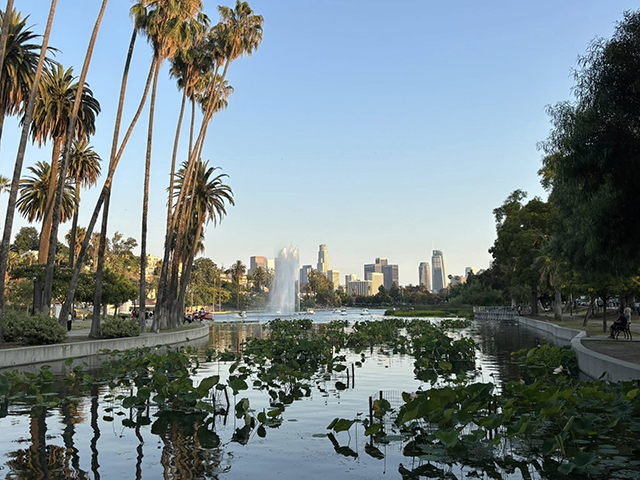
Pictured: Echo Park Lake. Photo courtesy Clement Lau.
Nestled just northwest of downtown Los Angeles, Echo Park Lake is one of the city’s most iconic public spaces. Its central feature — a lake surrounded by palm trees, pedal boats and skyline views — draws residents and visitors alike. Circling the lake is a popular paved walking path that supports a steady flow of walkers, joggers, families and cyclists, making the park feel alive at all hours.
What stands out about Echo Park Lake’s walking path is its urban vibrancy, fueled by the park’s energy and variety of use — unlike more secluded parks. You will see fitness enthusiasts doing laps, artists sketching on benches, and friends gathering for casual conversations along the loop. The path functions not only as a fitness amenity but as a social promenade, where people of all backgrounds share space and movement.
The paved path ensures accessibility for users of all abilities and blends seamlessly with the park’s lawns and shaded areas, where visitors engage in stretching, yoga or quiet observation. Echo Park Lake shows how a walking path can serve as both a health tool and a cultural corridor in the heart of a city.
Encanto Park
Located in the City of Duarte near the foothills of the San Gabriel Mountains, Encanto Park offers a calm and nature-filled walking experience in contrast to the bustle of the city. The park’s paths wind through trees, open lawns, and recreational amenities, offering both exercise and reflection in a setting that feels peaceful and restorative.
The walking path network at Encanto Park features a mix of decomposed granite and paved surfaces, with each material serving different functions. Roughly half the path system consists of decomposed granite, especially along nature-oriented segments near a bioswale. The rest is paved, supporting accessibility and use in high-traffic areas. This blend accommodates a variety of users, from casual walkers to parents with strollers. Combined with birdsong, mountain views and the park’s mature canopy, walking at Encanto Park is not just healthy — it is grounding and restorative.
What makes Encanto Park especially notable is its connection to the San Gabriel River Trail, a regional multi-use corridor stretching for miles through L.A. County. Walkers can extend their route from the park onto the river trail, moving beyond a neighborhood stroll into a much larger recreational experience. This kind of connectivity is a powerful example of how walking paths can link local parks to broader networks of green space and active transportation.
Walking Paths as Essential Infrastructure
What these parks demonstrate is that walking paths are not mere add-ons. They are vital infrastructure that supports community health, connection, and resilience. In many communities, especially those lacking safe sidewalks or green space, walking paths in parks may be the only accessible and secure places to walk. For people who do not drive or have limited mobility, these paths are lifelines — spaces where they can move freely, safely and with dignity.
Moreover, walking paths are cost-effective. Compared to larger capital projects, they require relatively modest investment and maintenance. Yet they deliver outsized benefits — not only in terms of public health, but also by encouraging daily park use, strengthening social ties, and enhancing perceptions of safety and beauty in public spaces.
Conclusion
Whether circling lakes in Willowbrook, winding through a suburban park in Alhambra, strolling around Echo Park Lake, or connecting to regional trails in Duarte, walking paths offer more than just a way to get from point A to point B. They invite us to slow down, breathe deeply, move with purpose and connect — with ourselves, with others, and with the places we call home. In uncertain times and tight budgets, walking paths are a smart investment with enduring impact. Sometimes, the most transformative journeys begin with a simple walk in the park.
Clement Lau, DPPD, FAICP, is a planner with over 17 years of park planning experience in Los Angeles County. He is a regular contributor to NRPA's Parks & Recreation magazine and Open Space blog.
